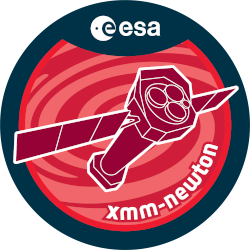

| Proposal ID | 089160 |
| Title | The nature of the most distant radio source known at z=7.0, a blazar |
| Download Data Associated to the proposal | https://nxsa.esac.esa.int/nxsa-sl/servlet/data-action-aio?obsno=0891600101 |
| DOI | https://doi.org/10.57780/esa-9zgwxl1 |
| Principal Investigator, PI | Dr Eduardo Banados |
| Abstract | Relativistic jets are thought to play a key role on the formation of massivegalaxies and supermassive black holes. Radio and X-ray observations provide themost direct probes of SMBHs accretion mechanisms and jets physics. However,currently there is a dearth of radio sources at z>=7, which in turn are a keymissing population for future 21 cm absorption studies well within the epoch ofreionization. We propose quasi-contemporary VLA/XMM observations of a newredshift-record radio source at z=7, for which archival non-simultaneous 1.4 and3.0GHz data reveal an atypical sharply rising spectrum of index +0.6 that couldbe compatible with a blazar. |
| Publications | No publications found for current proposal! |
| Instrument | EMOS1, EMOS2, EPN, OM, RGS1, RGS2 |
| Temporal Coverage | 2022-08-04T13:32:18Z/2022-08-05T04:47:28Z |
| Version | 20.08_20220509_1852 |
| Mission Description | The European Space Agencys (ESA) X-ray Multi-Mirror Mission (XMM-Newton) was launched by an Ariane 504 on December 10th 1999. XMM-Newton is ESAs second cornerstone of the Horizon 2000 Science Programme. It carries 3 high throughput X-ray telescopes with an unprecedented effective area, and an optical monitor, the first flown on a X-ray observatory. The large collecting area and ability to make long uninterrupted exposures provide highly sensitive observations. Since Earths atmosphere blocks out all X-rays, only a telescope in space can detect and study celestial X-ray sources. The XMM-Newton mission is helping scientists to solve a number of cosmic mysteries, ranging from the enigmatic black holes to the origins of the Universe itself. Observing time on XMM-Newton is being made available to the scientific community, applying for observational periods on a competitive basis. |
| Creator Contact | https://www.cosmos.esa.int/web/xmm-newton/xmm-newton-helpdesk |
| Date Published | 2023-08-23T00:00:00Z |
| Last Update | 2025-08-04 |
| Keywords | "XMM", "key role", "rising spectrum", "radio sources", "key missing population", "cm absorption", "supermassive black holes", "z >=", "massive galaxy", "jets physics", "quasi contemporary vla", "relativistic jets", "distant radio source", "0ghz data", "smbhs accretion mechanisms" |
| Publisher And Registrant | European Space Agency |
| Credit Guidelines | European Space Agency, Dr Eduardo Banados, 2023, 'The nature of the most distant radio source known at z=7.0, a blazar', 20.08_20220509_1852, European Space Agency, https://doi.org/10.57780/esa-9zgwxl1 |